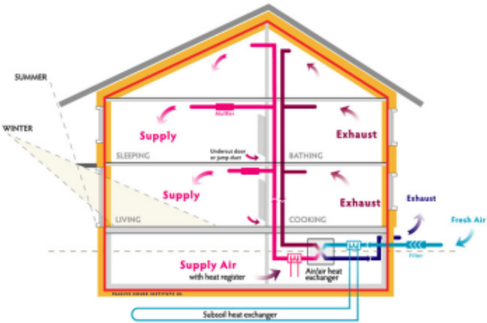 Have you ever wondered what the difference (if any) is between a passive solar home and a home built to a Certified Passive House standard? Turns out there is a big difference. Read on to learn just what sets these two building styles apart. PASSIVE SOLAR HOME “Passive solar” is a design approach that was popularized in the1970s in which heat from the sun is strategically captured to warm homes. Passive solar’s low-tech approach doesn’t abide by any established standard, however, the design principles are consistent in that Passive solar homes capitalize on solar heat that radiates through south-facing windows (north-facing windows if the home is in the Southern Hemisphere). As the sun warms the house, the heat is retained via insulation and by use of thermal mass (such as concrete, stones or tile) that stores and slowly releases it. When sunlight strikes a building, the building materials can reflect, transmit, or absorb the solar radiation. In addition, the heat produced by the sun causes air movement that can be predictable in designed spaces. These basic responses to solar heat lead to design elements, material choices and placements that can provide heating and cooling effects in a home. A complete passive solar design has five elements: 1. Aperture/Collector: The large glass area through which sunlight enters the building. The aperture(s) should face within 30 degrees of true south and should not be shaded by other buildings or trees. 2. Absorber: The hard, darkened surface of the storage element. The surface, which could be a masonry wall, floor, or water container, sits in the direct path of sunlight. Sunlight hitting the surface is absorbed as heat. 3. Thermal mass: Materials that retain or store the heat produced by sunlight. While the absorber is an exposed surface, the thermal mass is the material below and behind this surface. 4. Distribution: Method by which solar heat circulates from the collection and storage points to different areas of the house. A strictly passive design will use the three natural heat transfer modes- conduction, convection and radiation- exclusively. In some applications, fans, ducts and blowers may be used to distribute the heat through the house. 5. Control: Roof overhangs can be used to shade the aperture area during summer months. Other elements that control under and/or overheating include electronic sensing devices, such as a differential thermostat that signals a fan to turn on; operable vents and dampers that allow or restrict heat flow; low-emissivity blinds; and awnings. Modest levels of passive solar heating can reduce building auxiliary heating requirements from 5% to 25% at little or no incremental first cost. More aggressive passive solar heated buildings can reduce heating energy use by 25% to 75% compared to a typical structure while remaining cost-effective on a life-cycle basis. Advantages: • Direct gain passive solar homes are the easiest to implement. • The basic approach is extremely simple: orient south, add windows, insulate and tweak. • The designs have low environmental impact, especially if the greenest materials are used. • The direct gain requirements fit well into a multitude of architectural styles. • Direct gain passive solar homes are aesthetically pleasing. • Solar glazing can go on the front, sides or back of the house, whichever faces the sun. • Passive solar homes tend to have light, airy interiors which are bright and cheerful. • Direct gain designs get a lot of daylighting, reducing electrical bills and giving a pleasant living and working environment. • Direct gain homes with open plan designs can be smaller than traditional houses. • The extra solar glazing often gives exceptional views of natural beauty. • With appropriate thermal mass, solar homes are comfortable and warm, maintaining stable temperatures throughout the year with little additional heating. (for more on this subject, watch this interview we did with Ross Elliot, retired carpenter, energy advisor, and the former owner of Homesol Building Solutions.) Disadvantages: • The basic approach hides a lot of complexities and a great deal of careful balancing; there’s a lot you can get very wrong, very easily. • Over glazing and lack of shading in the summer months causes the home to overheat. • Too little thermal mass also causes the home to overheat. • Too much solar glazing can make the home very cold at night and on cloudy days. • All the extra daylighting can cause serious glare issues unless care is taken to create sun-free zones. • The extra light can also cause furnishings to fade, though modern advances in UV protection reduce the effect. • The solar glazing can turn into a heat sink if it is not properly insulated, or if the insulated shutters are a hassle to operate every night. • House plants – particularly tropicals – can suffer badly with too much sun in winter and not enough light in summer.  CERTIFIED PASSIVE HOUSE About 20 years after the popularization of passive solar homes, German physicist Wolfgang Feist founded the Passivhaus Institute (PHI), which formalized “Passivhaus.” Passivhaus is a comprehensive energy-efficient building standard that was influenced by early passive solar designs, but which placed more importance on an airtight envelope, high-efficiency windows and conditioned air recovery. Passive House is a building standard that is energy efficient, comfortable and ecological at the same time. It is not a brand name, but a construction concept. To be designated as a Certified Passive House, a building must embody a set of specific best practices that seal it from outside temperatures while maintaining a stable inside temperature and high air quality. When you call a house a "passive house" (not solar passive) you’re saying that it was built to the PHI’s rigorous standards (or PHIUS) for insulation and energy use. A home must follow the standard exactly to receive Passive House Certification (although certification is not required to build to such standards but it is proof that it was accomplished). With the dramatically reduced energy requirements, the need for conventional heating and cooling systems disappears. This frees up financial resources that can instead be used to make a home deeply efficient. Passive design strategy carefully models and balances a comprehensive set of factors including heat emissions from appliances and occupants to keep the building at comfortable and consistent indoor temperatures throughout the heating and cooling seasons. The rigorous Passive House standard doesn’t render passive solar design entirely obsolete. Many homes built to the Passive House standard use passive solar design as one tactic among many to make the home super-efficient. Advantages: • Passive House buildings allow for heating and cooling related energy savings of up to 90% compared with typical building stock. Passive House buildings use less than 1.5 litres of oil per square meter of living space per year – far less than typical low-energy buildings. Similar energy savings have been demonstrated in warm climates where buildings require more energy for cooling than for heating. • Passive House buildings are praised for their high level of comfort. They use energy sources inside the building such as the body heat from the residents or solar heat entering the building – making heating a lot easier. Appropriate windows with good insulation (which as a bonus creates a sound barrier for noise) and a building shell consisting of good insulated exterior walls, roof and floor slab keep the heat during winter in the house – and keep it out during summer. • A ventilation system consistently supplies fresh air making for superior air quality without causing any unpleasant draughts. A highly efficient heat recovery unit allows for the heat contained in the exhaust air to be re used. Energy (or Enthalpy) recovery ventilation is used to achieve maximum efficiency in passive house designs. Heat and humidity are exchanged between the air supply and exhaust, while reducing cooling costs in summer and heating costs in winter. When combined with smart ventilation controls, an ERV system can keep comfortable indoor temperatures with a minimal energy cost. For example, the ventilation rate is decreased when occupancy is low, saving fan power. During summer, the exhaust air removes heat from the fresh intake air. During winter, on the other hand, the exhaust air supplies heat to the intake air. • Another important principle is thermal bridge-free design: the insulation is applied without any “weak spots” around the whole building so as to eliminate cold corners as well as excessive heat losses. This method is another essential principle assuring a high level of quality and comfort in Passive House buildings while preventing damages due to moisture build up. • The standard takes extra precaution to seal all leaks around doors and windows, electrical outlets on exterior walls, sill plates, hose bibs, piping, and around recessed lights. It encourages a design with very few holes (for venting, e.g.) in the building envelope. Essentially, anywhere an air leak could occur, passive house construction will make extra efforts to plug them. It sounds complicated and expensive, but when details and materials are all reviewed and simplified from the start, it is one of the least costly principles. • Passive house construction allows for flexibility and design options meeting the owner’s wishes. One example is a large window with a panoramic view. The construction and design can prevent the loss of heat due to the large window surface. The solution is to add extra wall or roof insulation to the surrounding areas. Owners need to work with an experienced contractor to ensure all details for building a passive home are included in the planning. Disadvantages • The lack of consumer and industry trade knowledge is a major drawback for passive house construction. • The initial design and construction costs can be higher, compared to a traditional building. For instance, the outer wall thickness will vary depending on the site and climate zone. The design is dependent on the location and weather conditions. Owners need to consider the utility savings against the cost of passive building materials. The cost recovery begins immediately once the building is occupied and only gets better as time goes on. • Like all new features in a building, there’s a learning curve for new owners. The Passive House concept itself remains the same for all of the world’s climates, as does the physics behind it. Yet while Passive House principles remain the same across the world, the details do have to be adapted to the specific climate at hand and the people living in it. A building fulfilling the Passive House Standard will look much different in the Yukon than in Costa Rica. To conclude, the differences between Passive Solar home and Passive House Standard are many. It is important to understand first what is important and top priority for you and your family and to consult with an expert in the field before undertaking any new project. References: https://passiv.de/en/02_informations/01_whatisapassivehouse/01_whatisapassivehouse.htm https://sustainability.williams.edu/green-building-basics/passive-solar-design/ https://www.wbdg.org/resources/passive-solar-heating https://archive.curbed.com/2016/9/6/12583346/passive-house-construction-guide http://www.solar365.com/green-homes/heating-ac/pros-cons-direct-gain-passive-solar homes Comments are closed.
|
Archives
March 2024
Categories
All
|
|
CONTACT US
|
Copyright © 2020 The Conscious Builder Inc. All Rights Reserved.

